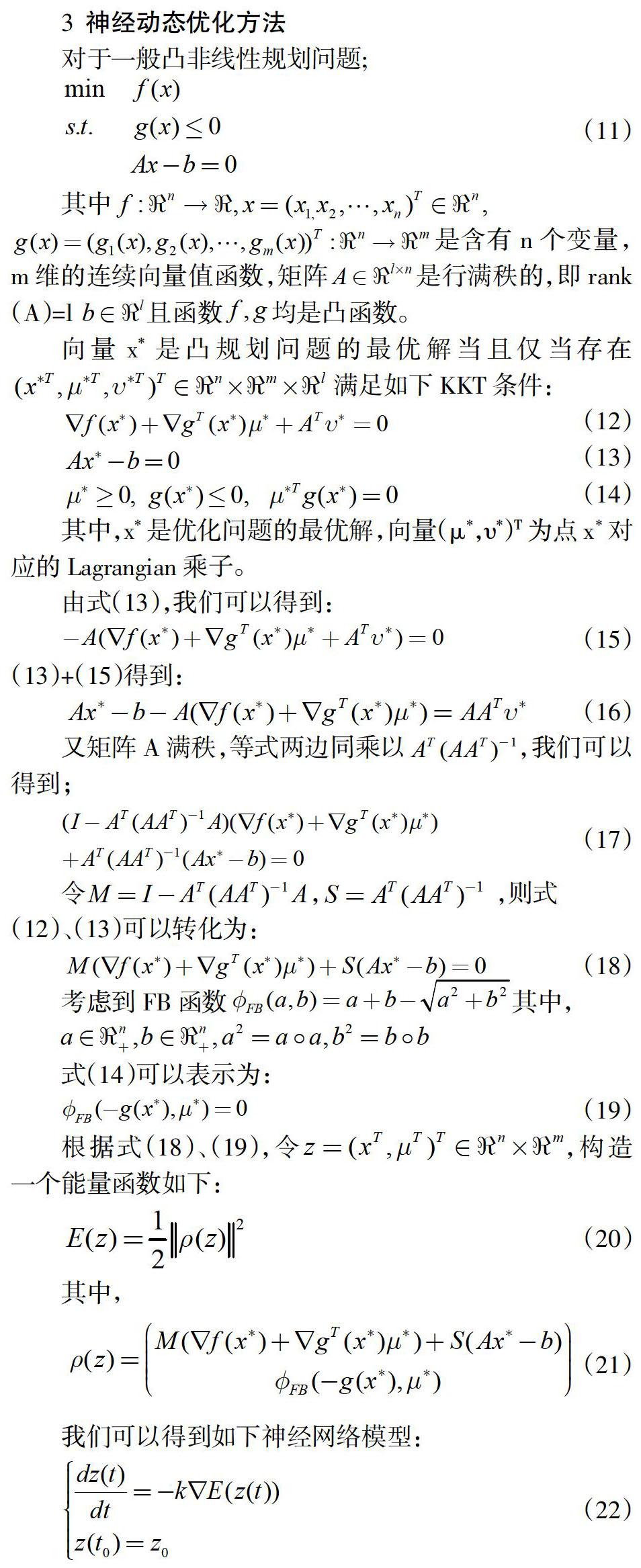基于神经动态优化的离散时滞系统预测控制
2018-06-05赵丽萍楼旭阳
赵丽萍 楼旭阳


摘 要:文章利用神经动态优化方法研究离散时滞系统预测控制问题,首先将离散时滞系统的模型预测控制问题转化为带约束的优化问题,再采用梯度神经网络进行在线求解。该神经网络具有较少的状态变量,结构简单,优化速度快,能够有效的解决带有约束的规划问题。仿真结果表明该神经动态优化方法可提高模型预测控制的在线计算能力。
关键词:离散时滞系统;梯度神经网络;模型预测控制
中图分类号:TP273 文献标志码:A 文章编号:2095-2945(2018)13-0025-04
Abstract: In this paper, the neural dynamic optimization method is used to study the predictive control problem for discrete time-delay systems. Firstly, the model predictive control problem for discrete time-delay systems is transformed into an optimization problem with constraints, and then the gradient neural network is used to solve the problem online. The neural network has fewer state variables, simple structure as well as fast optimization speed, and can effectively solve the programming problem with constraints. The simulation results show that the neural dynamic optimization method can improve the on-line computing ability of the model predictive control.
Keywords: discrete time-delay systems; gradient neural networks; model predictive control
1 概述
模型预测控制(Model Predictive Control,简称MPC)是一种基于预测模型的,在有限的时间内弥补现代控制理论最优控制缺点的闭环计算机控制算法。MPC主要有预测模型、滚动优化和反馈校正三个部分,预测模型主要是利用当前信息对未来输出做出预测,滚动优化则主要是随时间在线优化,使预测输出与给定的期望输出接近,然后通过反馈校正,使预测输出达到最佳。自20世纪70年代以来,模型预测控制在工业过程中已得到广泛应用[1-3],显现出其优于经典控制解决多变量、有约束工业过程控制问题的性能。
早期的模型预测控制研究中,系统模型大都是线性的,而大多数工业过程都是非线性的,因此尽管MPC在国内外工业应用中取得了广泛应用,在作為解决当前社会的约束优化问题时,仍存在不足。从已有算法来看,由于最终求解的优化问题包含模型和约束条件,求解过程中需要重复迭代,因此使得模型预测控制具有较大的在线计算量和较长的计算时间,限制了模型预测控制的实际应用范围。在应用对象方面,主要还是应用于线性和弱非线性系统,对于强非线性系统,用一个近似线性模型去逼近可能会导致控制性能的恶化,而目前对非线性的建模还比较困难。从应用方式看,由于现实物理条件约束的存在,我们目前还是很难得到精确的优化问题的解析式。因此,模型预测控制在优化问题还有很多限制,加大对模型预测控制在线优化的研究仍具有重要意义。
常规的控制理论研究需要预先知道被控对象的数学模型,而实际研究工业对象具有不确定性、时变性和非线性等特征。神经网络是一种黑箱建模方法,作为非线性系统建模的有力工具,可以以任意精度逼近任意非线性函数。此外,人工神经网络由大量神经元组成,在处理问题时可以以分布式进行并行操作,不随优化问题维数的增加而降低处理速度,并且人工神经网络在硬件上可以实现,较大的提高了优化速度,因此是一个很有前景的优化工具。Hopfield和Tank首先提出了Hopfield递归神经网络模型并解决了旅行商的优化问题[4],在[5]中,Kennedy和Chua通过梯度和惩罚函数方法提出了一个原始神经网络用于解决非线性规划问题,基于对偶和投影方法,Wang等人提出了几种求解优化问题的神经网络;如简化对偶神经网络[6],时滞神经网络[7],投影神经网络[8]等,仿真显示这些神经网络在解决优化问题方面都取得了很好的效果。
神经动态优化方法主要是通过将神经网络的平衡点和优化问题的最优解相同或近似,利用神经网络收敛到平衡点从而求解优化问题的一种新方法。目前神经动态优化的理论研究较多,其核心思想是设计神经网络的学习法则,主要设计方法包括投影法、拉格朗日函数法、对偶定理和罚函数法等[9]。文献[10]给出了两种具有全局收敛性的递归神经网络用于求解离散系统的模型预测控制优化问题。文献[11]则提出了一种简化对偶神经网络来解决非线性仿射系统的模型预测控制问题,而对带有鲁棒的系统的模型预测控制优化问题。文献[12]提出了一种两层神经网络,在[13]中则利用投影神经网络求解仿射系统的模型预测控制优化问题并将其应用于连续搅拌釜式反应器(CSTR)验证该神经动态优化方法的可行性和有效性,Lu等人则利用离散神经网络求解预测控制并通过硬件实现该优化方法[14]。
2 离散系统预测控制
考虑如下离散时滞系统:
文献[15]证明了该梯度神经网络是Lyapunov稳定且是指数收敛。根据神经网络的收敛条件,当目标函数是带有不等式约束的二次规划形式时,仍能满足收敛要求,此时该神经网络仍是Lyapunov稳定和指数收敛,因此可以用来求解优化问题(10)。
综上,基于离散时滞系统梯度神经网络模型预测控制优化算法如下:
4 结束语
本文针对离散时滞系统的模型预测控制问题,提出了基于梯度神经网络的神经动态优化方法。该方法扩大了模型预测控制优化的应用范围,较好的提高了在线计算速度,减少了在线计算时间。此外,该神经动态优化方法也可以用于其他非线性凸规划问题,丰富了模型预测控制在更多领域的应用和应用场合的推广。
参考文献:
[1]S. J. Qin and T. A. Badgwell. A survey of industrial model predictive control technology[J].Control Engineering Practice, 200
3,11(7):733-764.
[2]J. Richalet, A. Testud, L. J.,et al. Model predictive heuristic control: Applications to industrial processes [J].Automatica,1978,14:413-428.
[3]Y. Xi, D. Li, S. Lin. Model predictive control-Status and challenges [J]. Acta Automatica Sinica, 2013,39(3):222-236.
[4]J. J. Hopfield, D. W. Tank. Neural computation of decisions in optimization problems [J]. Biological cybernetics, 1985,52(3):141-152.
[5]M. P. Kennedy, L. O. Chua. Neural networks for nonlinear programming[J].IEEE Transaction on Circuits and Systems, 1988,
35(5):554-562.
[6]Q. Liu, J. Wang. A simplified dual neural network for quadratic programming with its KWTA application [J].IEEE Trans
action on Neural Networks, 2006,17(6):1500-1510.
[7]Q. Liu, J. Cao, Y. Xia. A delayed neural network for solving linear projection equations and its analysis [J]. IEEE Transaction on Neural Networks, 2005,16(4):834-843.
[8]Q. Liu, J. Wang. A projection neural network for constrained quadratic minimax optimization[J].IEEE Transactions on Neural
Networks and Learning Systems, 2015,26(11):2891-2900.
[9]单媛.基于神经动力學的水下滑翔机的模型预测控制[D].大连理工大学,2014.
[10]Y. Pan, J. Wang. Two neural network approaches to model predictive control [C]. Proceedings of the American Control Conference, Seattle, Washington, USA,2008:1685-1690.
[11]Y. Pan, J. Wang. Model predictive control for nonlinear affine systems based on the simplified dual neural network [C]. IEEE International Symposium on Intelligent Control,2009:683-688.
[12]Z. Yan, J. Wang. Robust model predictive control of nonlinear affine systems based on a two -layer recurrent neural network [C]. Proceedings of International Joint Conference on Neural Networks, San Jose, California, USA, 2011:24-29.
[13]Z. Yan, J. Wang. Model predictive control of nonlinear affine systems based on the general projection neural network and its application to a continuous stirred tank reactor[C].International Conference on Information Science and Technology, Nanjing, Jiangsu, China, 2011:1011-1015.
[14]Y. Lu, D. Li, et al. Convergence analysis and digital implementation of a discrete-time neural network for model predictive control [J].IEEE Transaction on Industrial Electronics, 2014,61(12):7035-7045.
[15]X. Huang, X. Lou, B. Cui. A novel neural network for solving convex quadratic programming problems subject to equality and inequality constraints[J].Neurocomputing,2016,214(12):23-31.
